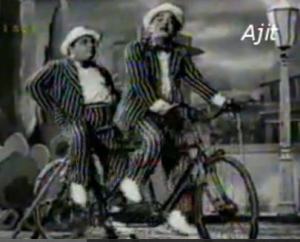 We are inviting comments and background information on this our central concept behind this project, i.e., what is this thing we call transportation equity all about? We are looking for a variety of views and perspectives on our topic and not some kind of warm and glass-eyed unanimity. If we cannot handle contradictions and fuzziness, then we are not about to make headway with this one. This first note comes in from Todd Litman executive director of the Victoria Transport Policy Institute in Victoria Canada.
We are inviting comments and background information on this our central concept behind this project, i.e., what is this thing we call transportation equity all about? We are looking for a variety of views and perspectives on our topic and not some kind of warm and glass-eyed unanimity. If we cannot handle contradictions and fuzziness, then we are not about to make headway with this one. This first note comes in from Todd Litman executive director of the Victoria Transport Policy Institute in Victoria Canada.
Wednesday, February 29, 2012
Thinking on Equity/Transport: Todd Litman, Canada
Tuesday, February 28, 2012
Gauging the socio-economic impacts of future urban transport initiatives
As we set out on the first of the city programs organized in this pioneering  Equity/Transport series, the Helsinki project that gets underway on 1 March, it is useful to bear in mind that to fully understand the concept of equity as a major driver of policy in the sector requires that we move well beyond the more traditional techniques of investment and impact analysis such as cost-benefit analysis. The authors take direct aim at this issue when they state: "The classical cost-benefit analysis, then, needs to be replaced by a socio-economic impact assessment methodology (SEIA) to get a measure of expected benefits and costs to different groups." So without further ado let's turn to see what the authors have to share with us on this important topic.
Equity/Transport series, the Helsinki project that gets underway on 1 March, it is useful to bear in mind that to fully understand the concept of equity as a major driver of policy in the sector requires that we move well beyond the more traditional techniques of investment and impact analysis such as cost-benefit analysis. The authors take direct aim at this issue when they state: "The classical cost-benefit analysis, then, needs to be replaced by a socio-economic impact assessment methodology (SEIA) to get a measure of expected benefits and costs to different groups." So without further ado let's turn to see what the authors have to share with us on this important topic.
Monday, February 27, 2012
Sunday, February 26, 2012
Friday, February 24, 2012
The Invisible Cyclist: Transportation Justice
From Equity-Based Transportation Systems: Paradigm Shift.
The transportation justice movement calls into question government subsidies of transportation forms that tend to benefit largely white and affluent urban and suburban commuters and advocates for better transit options and safer streets for poor people and people of color. This population of cyclists is largely uncounted, unrecognized, and unrepresented. Put simply, these are the invisible cyclists. In many cases, invisible cyclists are the constituents of transportation justice organizations, but only insofar as they are poor people of color. As cyclists, they remain invisible.
Wednesday, February 22, 2012
Equity-based Educational Reform in Finland
In the Helsinki stage of our on-going Equity/Transport program and process, it is particularly important that we have and share a clear understanding of the  manner in which the equity-base education reform process has transformed Finland's schools over the last decades from middling to world level (See OECD PISA results for verification). To this end we are gathering and presenting here a selection of reports and articles that help us in this respect. The following report was prepared by Mrs. Lorraine Frassinelli Ell in 2006, and while six years have intervened since she completed it, the paper still provides a good synopsis and expert outsider view of the Finnish experience from someone working internationally in the field of educational reform and measurement.
manner in which the equity-base education reform process has transformed Finland's schools over the last decades from middling to world level (See OECD PISA results for verification). To this end we are gathering and presenting here a selection of reports and articles that help us in this respect. The following report was prepared by Mrs. Lorraine Frassinelli Ell in 2006, and while six years have intervened since she completed it, the paper still provides a good synopsis and expert outsider view of the Finnish experience from someone working internationally in the field of educational reform and measurement.
Monday, February 20, 2012
Equity-Based Transportation Planning, Policy and Practice: First Helsinki project announcement
This week we initiate work on the first stages of preparatory organization in  support of an "open conversation" looking into the pros and cons, the possibilities and eventual impossibilities, of creating an equity-based transportation system at the level of a city and the surrounding region. This first pioneering project, in which we hope will become a series of leading world city projects building on this first example, is being carried out under the leadership of the Helsinki Department of City Planning and Transportation, and is running over the period mi-February through mid-April.
support of an "open conversation" looking into the pros and cons, the possibilities and eventual impossibilities, of creating an equity-based transportation system at the level of a city and the surrounding region. This first pioneering project, in which we hope will become a series of leading world city projects building on this first example, is being carried out under the leadership of the Helsinki Department of City Planning and Transportation, and is running over the period mi-February through mid-April.
Sunday, February 19, 2012
Weekend musing: Lewis Mumford on the city, in 1963. (Le plus ça change)
This is not the first time anyone addressed these themes. In the City in History,  a classic text of urban design. Mumford urged in 1963 that technology achieves a balance with nature and hoped for a rediscovery of urban principles that emphasised humanity’s organic relationship to its environment. Forty-five years on, the film clips look incredibly old and the message delivered in a rather morbid and factious manner (to quote Jane Jacobs), with a slightly ‘Outer Limits’ or ‘Twilight Zone’ ambience. Yet some of the key ideas promoted by Mumford have increasing resonance with the sustainability and green agenda of the early 21st century. In the increasingly praxis orientated and commodified world of urban design, whether anyone is listening or not is another matter.
a classic text of urban design. Mumford urged in 1963 that technology achieves a balance with nature and hoped for a rediscovery of urban principles that emphasised humanity’s organic relationship to its environment. Forty-five years on, the film clips look incredibly old and the message delivered in a rather morbid and factious manner (to quote Jane Jacobs), with a slightly ‘Outer Limits’ or ‘Twilight Zone’ ambience. Yet some of the key ideas promoted by Mumford have increasing resonance with the sustainability and green agenda of the early 21st century. In the increasingly praxis orientated and commodified world of urban design, whether anyone is listening or not is another matter.
Friday, February 10, 2012
Is World Streets doing its job?
We asked 100 experts for their views - - and 101 responded.
 The results are there for all to see and judge. And we now know that we are going to need collaboration and other forms of support if we are to continue this international sustainability adventure. Is what we are doing useful and worthy of support? 101 of our readers picked up their pens and responded to our question. 101 of our readers picked up their pens and responded to our question.
--> Read on:
The results are there for all to see and judge. And we now know that we are going to need collaboration and other forms of support if we are to continue this international sustainability adventure. Is what we are doing useful and worthy of support? 101 of our readers picked up their pens and responded to our question. 101 of our readers picked up their pens and responded to our question.
--> Read on:
Tuesday, February 7, 2012
World Streets 2012 – Focus Programs (Review draft)
If you wish to review and comment the latest working draft for our 2012 program, please click here.
--> Read on:Monday, February 6, 2012
Evaluating Public Transport Health Impacts
 In the last days on the Sustran Global South Forum, Gregorio Villacorta of Metro of Lima (Peru) posted the following question to the group: "We would like to find some paper about road safety and social inclusion relationated to Metros, or other massive public transport." In the usual good spirit of Sustran there were immediately several communications offering to lend a hand. This one from Todd Litman of the Victoria Transport Policy Institute is one that we think is well worth sharing here.
In the last days on the Sustran Global South Forum, Gregorio Villacorta of Metro of Lima (Peru) posted the following question to the group: "We would like to find some paper about road safety and social inclusion relationated to Metros, or other massive public transport." In the usual good spirit of Sustran there were immediately several communications offering to lend a hand. This one from Todd Litman of the Victoria Transport Policy Institute is one that we think is well worth sharing here.
Sunday, February 5, 2012
Progress report and work plan for 2012 - For comment and finalization
Dear Reader,
We have our work cut out for us in 2012. Look at the numbers. Despite the great efforts of the best and the brightest in leading cities and programs worldwide, we are still losing the sustainability wars. And we are losing them badly, whether in terms of climate, environment, resources, social justice, quality of life and, perhaps worse than the rest, in terms of those key underpinnings of efficiency and economy. Efficiency, economy and . . . equity are the indispensable pillars of a sustainability policy no matter what the sector. But more on that in a bit. --> Read on:
Saturday, February 4, 2012
Weekend leisure: Bollywood Bicycle Boogie's back
Take a break. It's the weekend. And even if you have seen some of these before, let's invite you to take your head out of that fat report and come with  Navdeep Asija and me to the movies in India, the Bollywood Bicycle Boogie. The idea behind World Streets has from the beginning been to seek out and share universal lessons, from specific times and different places but which, with a bit of thought, can open up our eyes, ears and hearts to many things, including with a bit of luck to ourselves and our own limitations and quirks. For this Sunday's musing Navdeep brought us a packet of Bollywood films for your weekend viewing pleasure. Let me turn over the word to Navdeep so that he can explain it for himself:
Navdeep Asija and me to the movies in India, the Bollywood Bicycle Boogie. The idea behind World Streets has from the beginning been to seek out and share universal lessons, from specific times and different places but which, with a bit of thought, can open up our eyes, ears and hearts to many things, including with a bit of luck to ourselves and our own limitations and quirks. For this Sunday's musing Navdeep brought us a packet of Bollywood films for your weekend viewing pleasure. Let me turn over the word to Navdeep so that he can explain it for himself:
Friday, February 3, 2012
Network Media. (Do we know what we are doing?)
If that's a question, then the answer is a resounding . . . kind of. The truth is that  we are not embarrassed to say that when it comes to the new network media we are entirely improvising. On the net today there are no straight lines: everything changes so fast that what may look pretty good at one point may suddenly become absolutely vital to our operations -- or, at the other end of the spectrum, deceive, or worse yet even offer some dangers. It is, in a phrase, a real existential drama, but since we are trying to communicate on a world wide scale, we really have no chance but to try to take all these bits and pieces in hand and do with them the best we can. E pur si muove!
we are not embarrassed to say that when it comes to the new network media we are entirely improvising. On the net today there are no straight lines: everything changes so fast that what may look pretty good at one point may suddenly become absolutely vital to our operations -- or, at the other end of the spectrum, deceive, or worse yet even offer some dangers. It is, in a phrase, a real existential drama, but since we are trying to communicate on a world wide scale, we really have no chance but to try to take all these bits and pieces in hand and do with them the best we can. E pur si muove!
Thursday, February 2, 2012
Is World Streets doing its job? We asked 100 experts for their views - - and 101 responded.
"World Streets needs to catch on before my feet get wet." The Netherlands
 The results are there for all to see and judge. And we now know that we are going to need a literal world wide web of inputs, collaboration and other forms of support if we are to continue this independent international sustainability adventure in the year ahead. Is what we are doing useful and worthy of support? 101 of our readers picked up their pens and responded to our question.
--> Read on:
The results are there for all to see and judge. And we now know that we are going to need a literal world wide web of inputs, collaboration and other forms of support if we are to continue this independent international sustainability adventure in the year ahead. Is what we are doing useful and worthy of support? 101 of our readers picked up their pens and responded to our question.
--> Read on:
Wednesday, February 1, 2012
From the editor: Safe Streets? Who cares?
 It is a truly dreadful thing for anyone, me for instance, to lay on you anything as hackneyed as: a picture is worth a thousand words. But let me run the risk and show you a couple of pictures and leave it to you to draw your own conclusions. The topic is the first round of reactions to our start-up 2012 collaborative project aiming at clarifying the concept of Safe Streets from a strategic planning and policy perspective.
It is a truly dreadful thing for anyone, me for instance, to lay on you anything as hackneyed as: a picture is worth a thousand words. But let me run the risk and show you a couple of pictures and leave it to you to draw your own conclusions. The topic is the first round of reactions to our start-up 2012 collaborative project aiming at clarifying the concept of Safe Streets from a strategic planning and policy perspective.




